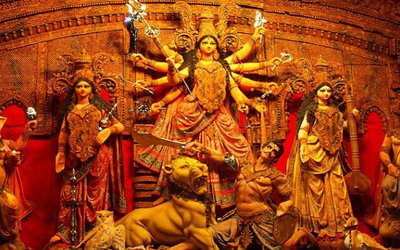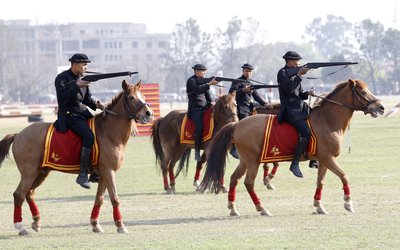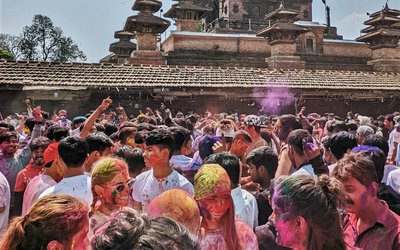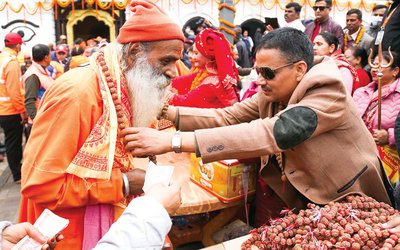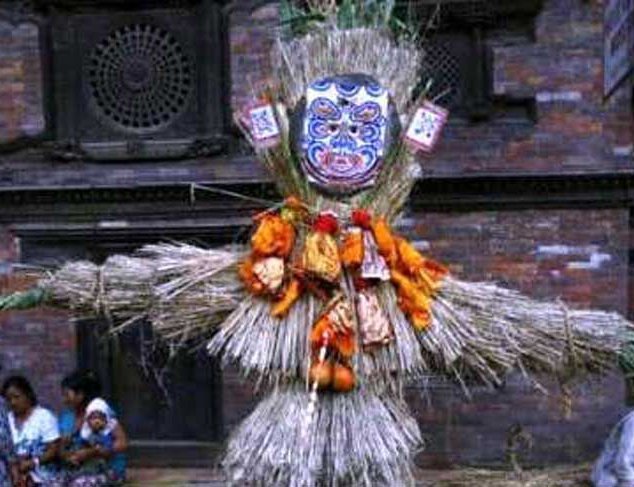
Gathemangal (Ghantakarna Chaturdashi) is one of the most important festivals of Kathmandu Valley and Newar settlements in different parts of Nepal. In 2024, Gathemangal is celebrated on August 2, Friday.
Gathemangal is a festival celebrated each year on Shrawan Krishna Chaturdashi, in the month of June/July. Gathemangal or Ghantakarna Chaturdasi is a co-relatively used the term as a festive to worship and offer sacrifices to demons. Gathemangal is celebrated in Newar community and observed in different parts of Kathmandu Valley.
There is a myth that a legendary demon named “Ghantakarna” was existed and spread the negativity and cruelness among the people. To get rid of this, Newars prepared dummies demons and are erected at the crossroads. The Ghantakarna is made up of straws, bamboo leaves for body parts, while the face is made of nanglo (a bamboo round plate-like used in Nepali kitchens for sifting rice) with art placed to it and bells, are used to signify ears. It is taken around the city and at the end of the day, it is dragged to the nearby river bank for disposal and burn at the chowks of the city.
Numerous legends are associated with this festival. Nobody knows the exact evolution of this culture but many said that it was celebrated since the Lichhavi era. According to beliefs, Ghantakarna with a pair of bells on his ears used to terrify people by killing them. That was the reason people called Ghanta (Bell) and Karna (Ears). People tried killing them by deceiving but couldn’t get success. Later, a clever frog was successful enough to kill him in a swamp when he was on his way to hunting. This particular day was believed to mark as the celebration of Ghantakarna Festival.
On this day, people also wear iron rings on their fingers with a belief of protecting them from the evil spirits and the demons. The iron rings are originally made by the Nakarmis (Newars who traditionally work to make iron equipment). The ring has faith in protecting people from unpleasant and evil spirits. People on this day get back home early and at night, they hammered the three-legged nails on the doors to get away from the ghosts to house.
At home, people clean their houses and prepared Samaybaji (a food mixed of beaten rice, ginger, black soyabeans, chhoila, potato, garlic). They stick a small patch of cow’s dung with different plants in the doors to purify their house. They also burn wheat hay in every nook and corner of the house to take away misfortunes.
Gatha Muga Cha: re ( गथांमुगः चर्हे )
Gatha Muga Cha: re ( गथांमुगः चर्हे ) or the Ghantakarna Chaturdashi or Gathamuga Charhe is a regional festival, mostly celebrated within the Kathmandu Valley. However, there are different stories and reasons to celebrate Gatha Muga cha: re, even in between these three cities of the Kathmandu valley.
Meanwhile, within Bhaktapur, Gatha Muga Cha: Re showcases the sign of the beginning of the festive season. Plus, the start of the reincarnation process of Nava Durga deities. On the same date, the Nava Durga mask dancers go to the house of the respected Prajapati people to ask where exactly they could get the dark-shaded clay for mask making.
After the Bhagasti, people started to get busy with rice manor and so related agricultural work. Within that monsoon period, they overlook playing musical instruments, even at their residences.
The city of festivals, music, and dance abruptly turns out into an agro-focused city. That purely, for a whole month or even more. Thus, this day as the first festival of the year again ties everyone with their musical instruments (Dhime Baja).
The Gatha Muga Cha: re is also designated as the Kya Macha festival. From when the one-month large Lakhey Dance series also starts.
The people of Kathmandu and Lalitpur call this festival Gathe Mangal rather than Gatha Muga Cha: re. Impartially there are a lot of myths and stories related to this festival. However, most people get involved in this festival, in the belief to bid farewell to demons. Despite that, they follow different stories to celebrate this festival.
Myths of the Ghantakarna Festival
There is no exact explanation of the celebration of this festival in history. Somehow the Gopalrajbamsawali says that it was first mentioned during the period of Malla’s reign.
Whether it is a myth or not, the Gathas, who represent the Nava Durga dance ceremonies, make Shivalinga on the day of Gatha Muga Cha: re. And, worship it to get blessings for the further process of mask-making.
In another belief, the Gatha Muga or the Ghantakarna is believed as a portion of Lord Shiva. Who somehow plays the role of being a nonreligious person as Lord Shiva does. If we analyze his character, then we can find that he pretends to be the one who wants nothing and thus care for no one.
But you see, all the negative things, including the poison, and evil spirits, he holds all these things for others.
Likewise, the Ghantakarna had a lot of sympathy towards the poor people. Only he was against religious beliefs. Instead, he believed in karma and hard work. That’s why he hung up bells in his ears so that he couldn’t hear any repute of the gods.
But, at the end of his life, no one wanted to do his cremation due to his undefined religious status. Yet, because of his good deeds toward poor people, they all decided to do his cremation by collecting the fund and did so.
The story from the Kathmandu
The people of Kathmandu believe that the Ghantakarna was a good demon, who partially help them on the rice plantation. Due to the lack of human force, they needed a supernatural force to complete their agro work. Otherwise, they would die from hunger and food scarcity.
Thus, they invite those supernatural spirits within them during the monsoon and then bid farewell on the day of Gathe Mangal. They would probably not bid farewell to those spirits if they could fulfill the needs of those spirits. It’s not like they demand so much but they were so powerful that they get often more hungry than a normal person.
Nonetheless, people couldn’t afford that. That’s why they were sent to their places, once the fieldwork settles.
According to another myth, Ghantakarna ( a demon with bells in his ears) used to muddle the life of people. Eating humans and frightening them to death were his favorite things to do. People were so terrified by him that they began to stay in their houses, just like in the lockdown.
Since there were no signs of humans crossing the crossroad, the demon did not get anything to eat. Consequently, he started to go search for humans rather than waiting for them at the crossroads. One powerful Tantrik somehow got to know about this state of that demon.
That’s why Tantric transformed himself into a frog and went to that demon. The frog-faced Tantrik told Ghantakarna that some human beings live across the river and made that demon go cross that water barrier. But, the supposed to be river turns out to be a swamp.
Ghantakarna easily fell for this trick and got into the swap which caused his death. That’s why the frogs are also fed rice as their reward some other day after Gatha Muga Cha: re.
The making of Ghantakarna in Bhaktapur
In this locally celebrated festival, People made out of a figure of a demon named Ghantakarna. The local people make Ghantakarna using wheat straw, bamboo, and branches of the tree. They made three legs of it.
Also, the local women prepare dolls (Katamari) to add to the demon’s figure. They believe that the dolls might have souls, which probably could be a bad one. Thus to get rid of any kind of evil spirit, they attached it to the Ghantakarna.
Gatha Muga Cha: re
Making the Gatha Muga during Gatha Muga Cha: re PC: Ram Maka
Furthermore, they also added some paint to picturesque the image of the demon. However, even with such a terrifying combination, it looks quite eye-contagious. With a musical performance, the Gatha Muga or the Ghantakarna is brought into the streets.
After roaming a little around, it is burned down in between the streets, far more in the crossroads and somewhere near the rivers too.
The local beliefs and rituals of Gathamuga Charhe
People made their children pass over the burning fire, where the gatha muga is burned. They execute this in the belief that their children will not get into trouble with any evil powers.
People also wear wrought iron metal rings on the same day. And continues to wear it for another four days. So that they would be protected from evil spirits.
The evening puja is held out in every household in the city, which after, they shut the doors of the house and remain in it.
On the same night, it was believed that the witches became so active plus did their prayers. So, just to avoid meetings with them, people remain in their residences after the puja.
A decade ago, people also used to throw their clay utensils after cleaning up the house. But nowadays, they don’t throw it. Cause, they no more use such utensils.
There is also another belief that onward this day the number of mosquitoes will reduce. Thus, autumn starts.
Additionally, from this day forward, the practice will begin for all of the dances that will be performed during Gai Jatra.
- IWMMI: Water Resilience Tracker
- Apr 02, 2025
- Nepal-India Signed Memorandum of Understanding (MoU) For 10 Projects
- Apr 02, 2025
- UNRCPD To Host Confernce On Small Arms
- Apr 02, 2025
- Weather Forecast: Partly Cloudy In Kathmandu And Pokhara
- Apr 02, 2025
- Winter Session Of Parliament Ends
- Apr 01, 2025

